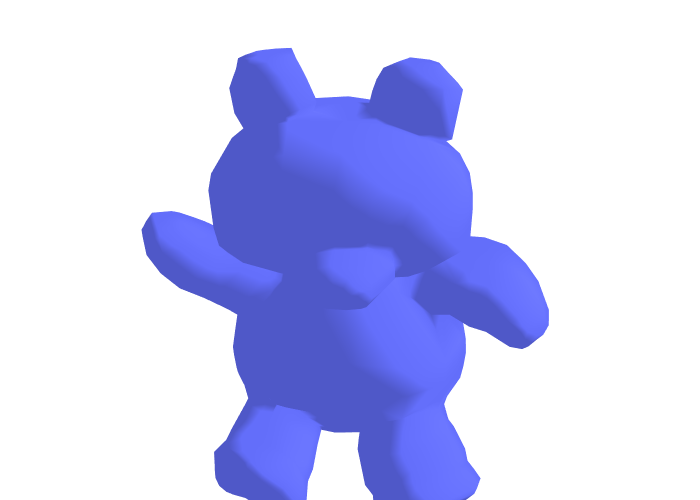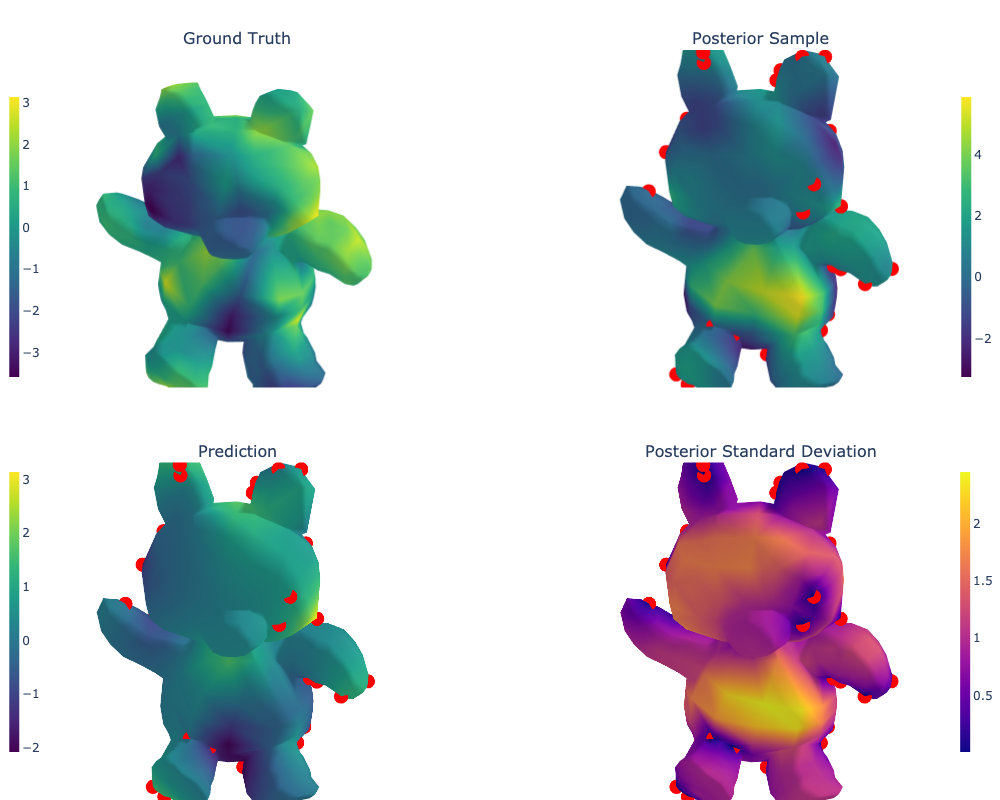[1]:
# To run this in Google Colab, uncomment the following line
# !pip install geometric_kernels
# If you want to use a version of the library from a specific branch on GitHub,
# say, from the "devel" branch, uncomment the line below instead
# !pip install "git+https://github.com/geometric-kernels/GeometricKernels@devel"
Gaussian Process Regression on a Mesh with GPyTorch¶
This notebooks shows how to fit a GPyTorch Gaussian process (GP) on a mesh.
[1]:
# Import a backend, we use torch in this example.
import gpytorch
import torch
# Import the geometric_kernels backend.
import geometric_kernels
import geometric_kernels.torch
# Import the Mesh space and the general-purpose MaternGeometricKernel
from geometric_kernels.spaces.mesh import Mesh
from geometric_kernels.kernels import MaternGeometricKernel
# The GPyTorch frontend of GeometricKernels
from geometric_kernels.frontends.gpytorch import GPyTorchGeometricKernel
# Sampling routines we will use to create a dummy dataset
from geometric_kernels.kernels import default_feature_map
from geometric_kernels.sampling import sampler
from geometric_kernels.utils.utils import make_deterministic
# Stuff
import numpy as np
import optax
import plotly.graph_objects as go
from plotly.subplots import make_subplots
from pathlib import Path
INFO (geometric_kernels): Numpy backend is enabled, as always. To enable other backends, don't forget `import geometric_kernels.*backend name*`.
INFO (geometric_kernels): Torch backend enabled.
Mesh Plotting Utils for plotly¶
[2]:
def update_figure(fig):
"""Utility to clean up figure"""
fig.update_layout(scene_aspectmode="cube")
fig.update_scenes(xaxis_visible=False, yaxis_visible=False, zaxis_visible=False)
# fig.update_traces(showscale=False, hoverinfo="none")
fig.update_layout(margin=dict(l=0, r=0, t=0, b=0))
fig.update_layout(plot_bgcolor="rgba(0,0,0,0)", paper_bgcolor="rgba(0,0,0,0)")
fig.update_layout(
scene=dict(
xaxis=dict(showbackground=False, showticklabels=False, visible=False),
yaxis=dict(showbackground=False, showticklabels=False, visible=False),
zaxis=dict(showbackground=False, showticklabels=False, visible=False),
)
)
return fig
def plot_mesh(mesh: Mesh, vertices_colors = None, **kwargs):
plot = go.Mesh3d(
x=mesh.vertices[:, 0],
y=mesh.vertices[:, 1],
z=mesh.vertices[:, 2],
i=mesh.faces[:, 0],
j=mesh.faces[:, 1],
k=mesh.faces[:, 2],
intensity=vertices_colors,
**kwargs
)
return plot
Defining a Space¶
First, we create a GeometricKernels space that corresponds to a teddy bear mesh loaded from “../data/teddy.obj”
[3]:
mesh = Mesh.load_mesh(str(Path.cwd().parent / "data" / "teddy.obj"))
print("Number of vertices in the mesh:", mesh.num_vertices)
Number of vertices in the mesh: 1598
Now we actually visualize the mesh.
[4]:
# Define the camera
camera = dict(
up=dict(x=0, y=1, z=0),
center=dict(x=0, y=0, z=0),
eye=dict(x=0, y=0.7, z=1.25)
)
plot = plot_mesh(mesh)
fig = go.Figure(plot)
update_figure(fig)
fig.update_layout(
scene_camera=camera
)
fig.show("png")

Create a Dummy Dataset on the Mesh¶
We sample from the prior of a GP to create a simple dataset we can afterwards fit using an exact Gaussian process regression (GPR) model.
The input set \(X \in \mathbb{N}^{n \times 1}\) consists of indices enumerating vertices of the mesh. Consequently, the elements of \(X\) are in \([0, N_v-1]\), where \(N_v\) are the number of vertices in the mesh. We sample num_data of them into the tensor called xs_train. For test inputs xs_test, we use the whole \(X\).
[5]:
num_data = 50
key = torch.Generator()
key.manual_seed(1234)
xs_train = torch.randint(low=0, high=mesh.num_vertices, size=(num_data, 1), generator=key, dtype=torch.int64)
xs_test = torch.arange(mesh.num_vertices, dtype=torch.int64)[:, None]
# print("xs_train:", xs_train)
# print("xs_test:", xs_test)
To generate the corresponding outputs ys_train and ys_test, we sample from the prior. To do this, we create a MaternGeometricKernel object and use the efficent sampling functionality of GeometricKernels.
[6]:
base_kernel = MaternGeometricKernel(mesh)
params = base_kernel.init_params()
params["lengthscale"] = torch.tensor([5.0], dtype=torch.float64)
params["nu"] = torch.tensor([2.5], dtype=torch.float64)
feature_map = default_feature_map(kernel=base_kernel)
sample_paths = make_deterministic(sampler(feature_map), key)
_, ys_train = sample_paths(xs_train, params)
key, ys_test = sample_paths(xs_test, params)
ys_train = ys_train[:, 0]
ys_test = ys_test[:, 0]
assert(torch.allclose((ys_test[xs_train[:, 0]]), ys_train))
Build a GPyTorch Model¶
Now we wrap the base_kernel created above into the GPyTorchGeometricKernel to make an actual GPyTorch kernel.
Note: params are external to the base_kernel object, thus we need to pass them to the GPyTorchGeometricKernel explicitly. Otherwise it will use params = base_kernel.init_params(). The trainable_nu parameter changes whether to treat the smoothness parameter "nu" as trainable or fixed. trainable_nu = True only works for finite values of "nu", it is incompatible with nu = inf.
Note: aligning with the standard GPyTorch conventions, GPyTorchGeometricKernel does not maintain a variance (outputscale) parameter. To add it, we wrap it into the gpytorch.kernels.ScaleKernel.
[7]:
kernel = gpytorch.kernels.ScaleKernel(
GPyTorchGeometricKernel(
base_kernel,
nu = params["nu"],
lengthscale=params["lengthscale"],
trainable_nu=False
)
)
kernel.outputscale = 1.0
We use the data xs_train, ys_train and the GPyTorch kernel kernel to construct a GPyTorch model.
[8]:
class ExactGPModel(gpytorch.models.ExactGP):
def __init__(self, train_x, train_y, likelihood, kernel):
super(ExactGPModel, self).__init__(train_x, train_y, likelihood)
self.mean_module = gpytorch.means.ZeroMean()
self.covar_module = kernel
def forward(self, x): # pylint: disable=arguments-differ
mean_x = self.mean_module(x)
covar_x = self.covar_module(x)
return gpytorch.distributions.MultivariateNormal(mean_x, covar_x)
likelihood = gpytorch.likelihoods.GaussianLikelihood(
noise_constraint=gpytorch.constraints.GreaterThan(1e-6)
)
likelihood.noise = torch.tensor(1e-4)
model = ExactGPModel(xs_train, ys_train, likelihood, kernel)
# use float64:
model.double()
likelihood.double()
print("Initial model:")
print("kernel.base_kernel.nu =", model.covar_module.base_kernel.nu)
print("kernel.base_kernel.lengthscale =", model.covar_module.base_kernel.lengthscale)
print("kernel.outputscale =", model.covar_module.outputscale)
print("likelihood.obs_noise =", model.likelihood.noise)
print("")
# Note: this is divided by the number of data points, hence may appear
# quite different from the marginal log likelihoods of other frontends.
mll = gpytorch.mlls.ExactMarginalLogLikelihood(likelihood, model)
print("Initial negative log marginal likelihood:", -mll(model(xs_train), ys_train).detach().numpy())
Initial model:
kernel.base_kernel.nu = tensor([2.5000], dtype=torch.float64)
kernel.base_kernel.lengthscale = tensor([[5.0000]], dtype=torch.float64, grad_fn=<SoftplusBackward0>)
kernel.outputscale = tensor(1.0000, dtype=torch.float64, grad_fn=<SoftplusBackward0>)
likelihood.obs_noise = tensor([0.0001], dtype=torch.float64, grad_fn=<AddBackward0>)
Initial negative log marginal likelihood: 1.0602498316296387
Train the Model (Optimize Hyperparameters)¶
[9]:
# Put the model into training mode
model.train()
likelihood.train()
# Use the Adam optimizer, with a set learning rate
optimizer = torch.optim.Adam(model.parameters(), lr=0.1)
# Set the number of training iterations
n_iter = 100
print("Starting training...")
for i in range(n_iter):
# Set the gradients from previous iteration to zero
optimizer.zero_grad()
# Output from model
output = model(xs_train)
# Compute loss and backprop gradients
loss = -mll(output, ys_train)
loss.backward()
if i == 0 or (i+1) % 10 == 0:
print("Iter %d/%d - Loss: %.5f" % (i + 1, n_iter, loss.item()))
optimizer.step()
print("")
print("Final model:")
print("kernel.base_kernel.nu =", model.covar_module.base_kernel.nu)
print("kernel.base_kernel.lengthscale =", model.covar_module.base_kernel.lengthscale)
print("kernel.outputscale =", model.covar_module.outputscale)
print("likelihood.obs_noise =", model.likelihood.noise)
print("")
print("Final negative log marginal likelihood:", -mll(model(xs_train), ys_train).detach().numpy())
Starting training...
Iter 1/100 - Loss: 1.06025
Iter 10/100 - Loss: 1.04504
Iter 20/100 - Loss: 1.03580
Iter 30/100 - Loss: 1.02686
Iter 40/100 - Loss: 1.01946
Iter 50/100 - Loss: 1.01455
Iter 60/100 - Loss: 1.01177
Iter 70/100 - Loss: 1.01036
Iter 80/100 - Loss: 1.00962
Iter 90/100 - Loss: 1.00920
Iter 100/100 - Loss: 1.00894
Final model:
kernel.base_kernel.nu = tensor([2.5000], dtype=torch.float64)
kernel.base_kernel.lengthscale = tensor([[4.7630]], dtype=torch.float64, grad_fn=<SoftplusBackward0>)
kernel.outputscale = tensor(1.1021, dtype=torch.float64, grad_fn=<SoftplusBackward0>)
likelihood.obs_noise = tensor([1.1084e-06], dtype=torch.float64, grad_fn=<AddBackward0>)
Final negative log marginal likelihood: 1.008915539826498
Draw Predictions and Evaluate the Model¶
Recall that xs_test contains all the locations on the mesh, i.e. all numbers from the set \(\{0, 1, \ldots, N_v-1\}\).
[10]:
# switch model to prediction mode
model.eval()
# print(xs_train.shape, xs_test.shape, ys_train.shape, ys_test.shape)
# predict mean and variance
latent_dist = model(xs_test)
posterior_mean = torch.reshape(latent_dist.mean, ys_test.shape).detach().numpy()
posterior_std = torch.reshape(latent_dist.stddev, ys_test.shape).detach().numpy()
# predict sample
sample = latent_dist.sample(sample_shape=torch.Size([1])).detach().numpy()[0, :]
[11]:
# Mark training data
training_data_coords = mesh.vertices[xs_train[:, 0]]
training_data_plot = go.Scatter3d(
x=np.array(training_data_coords[:, 0]),
y=np.array(training_data_coords[:, 1]),
z=np.array(training_data_coords[:, 2]),
mode = "markers",
marker_color = "red",
name="",
showlegend=False,
)
# Various plots as plotly traces
ground_truth_plot = plot_mesh(mesh, vertices_colors=ys_test, colorscale="Viridis",
colorbar=dict(
x=0,
y=0.75,
xanchor="center",
yanchor="middle",
len=0.4,
thicknessmode="fraction",
thickness=0.01)
)
sample_plot = plot_mesh(mesh, vertices_colors=sample, colorscale="Viridis",
colorbar=dict(
x=1.0,
y=0.75,
xanchor="center",
yanchor="middle",
len=0.4,
thicknessmode="fraction",
thickness=0.01)
)
posterior_mean_plot = plot_mesh(mesh, vertices_colors=posterior_mean, colorscale="Viridis",
colorbar=dict(
x=0.0,
y=0.25,
xanchor="center",
yanchor="middle",
len=0.4,
thicknessmode="fraction",
thickness=0.01)
)
posterior_std_plot = plot_mesh(mesh, vertices_colors=posterior_std, colorscale="Plasma",
colorbar=dict(
x=1.0,
y=0.25,
xanchor="center",
yanchor="middle",
len=0.4,
thicknessmode="fraction",
thickness=0.01)
)
# Setting up the layout
fig = make_subplots(
rows=2, cols=2,
specs=[[{"type": "surface"}, {"type": "surface"}],
[{"type": "surface"}, {"type": "surface"}]],
subplot_titles=(r"Ground Truth",
r"Posterior Sample",
r"Prediction",
r"Posterior Standard Deviation"),
vertical_spacing=0.1)
# Adding the traces
fig.add_trace(ground_truth_plot, row=1, col=1)
fig.add_trace(training_data_plot, row=1, col=2)
fig.add_trace(sample_plot, row=1, col=2)
fig.add_trace(training_data_plot, row=2, col=1)
fig.add_trace(posterior_mean_plot, row=2, col=1)
fig.add_trace(training_data_plot, row=2, col=2)
fig.add_trace(posterior_std_plot, row=2, col=2)
fig = update_figure(fig)
fig.layout.scene1.camera = camera
fig.layout.scene2.camera = camera
fig.layout.scene3.camera = camera
fig.layout.scene4.camera = camera
fig.update_layout(
margin={"t": 50},
)
fig.show("png", width=1000, height=800)

Citations¶
If you are using meshes and GeometricKernels, please consider citing
@article{mostowsky2024,
title = {The GeometricKernels Package: Heat and Matérn Kernels for Geometric Learning on Manifolds, Meshes, and Graphs},
author = {Peter Mostowsky and Vincent Dutordoir and Iskander Azangulov and Noémie Jaquier and Michael John Hutchinson and Aditya Ravuri and Leonel Rozo and Alexander Terenin and Viacheslav Borovitskiy},
year = {2024},
journal = {arXiv:2407.08086},
}
@inproceedings{borovitskiy2020,
title={Matérn Gaussian processes on Riemannian manifolds},
author={Viacheslav Borovitskiy and Alexander Terenin and Peter Mostowsky and Marc Peter Deisenroth},
booktitle={Advances in Neural Information Processing Systems},
year={2020}
}
@article{sharp2020,
author={Nicholas Sharp and Keenan Crane},
title={A Laplacian for Nonmanifold Triangle Meshes},
journal={Computer Graphics Forum (SGP)},
volume={39},
number={5},
year={2020}
}
[ ]: